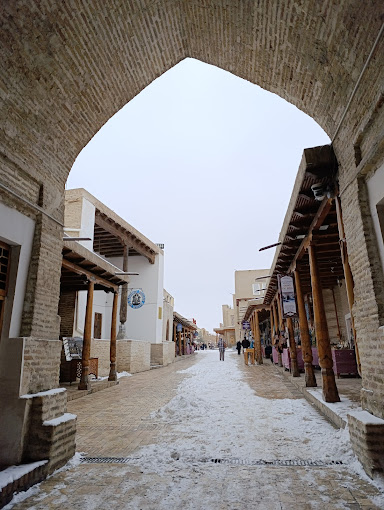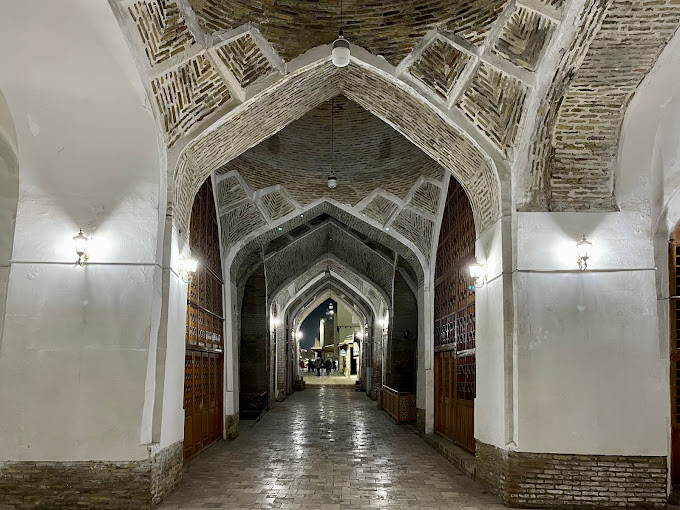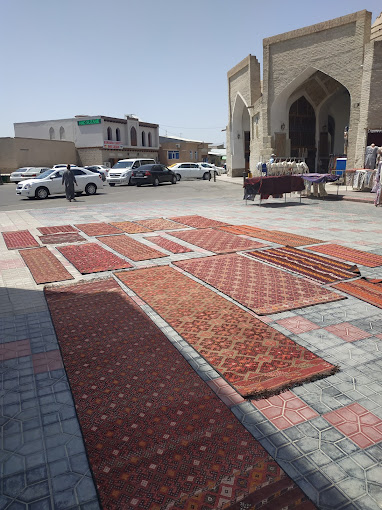Telpak Furushon Shopping Dome
Toki-Telpak Furushon (in some sources — Taki-Telpakfurushon) is one of the preserved traditional indoor bazaars of Bukhara. It was built in 1570-1571 under Abdullah Khan II, one of the rulers of the Sheibanid dynasty. It was the Sheibanids who began to turn Bukhara into a major trading center located at the intersection of many caravan roads. The trade domes, which gathered merchants from different parts of the world under their roofs, became a symbol of achieving this goal.
The material from which the trading dome is built is ceramic brick. This unusual structure is based on a peculiar hexagon. This urban planning solution was very convenient in terms of compactness, since the Furushon Telpack was built at an intersection where five streets converged in one place. Its central part is an amazingly beautiful spherical dome, in which small openings are cut. The dome is held by six pylons, it has a 12-faceted light lantern, tourists are especially interested in looking at the dome from the inside.
The diameter of the main dome of Toki-Telpak Furushon is 14.5 meters.
In addition to the main dome, small domes were built above the shopping gallery with niches. Storerooms, caravanserais for visiting merchants, and warehouses for goods for sale were usually located around the main dome. The exit from the western passage of the shopping dome leads to Mehtar Ambar Street, where you can explore the ancient Kulet caravanserai, where travelers used to rest in ancient times. As part of the historical part of Bukhara, the dome is included in the UNESCO World Heritage List.
Trading
In the 16th century, Bukhara became famous as a major shopping center, and the bazaars on its streets began to turn into large markets. A feature of that time was the placement of shops on different streets, depending on the type of products sold. In order to create the most favorable conditions for trade and merchants traveling along the Great Silk Road, the construction of trade domes began — multi-vaulted arched ceilings at intersections and squares called "currents". Traders from India, the Russian Empire, Iran, China and many other countries came here. It can be said that the trading domes of medieval Bukhara were the prototype of modern shopping centers, but they differed in that each of them could purchase one specific type of product.
Initially, booksellers gathered under the dome of Telpak Furushon. For this reason, its original name is Kitab—Furushon, which literally means "dome of book sellers" in Russian. Then, under the arches of Telpak Furushon, they began to sell all kinds of hats for adults and children, men and women: skullcaps embroidered with beads, gold or precious stones, massive telpaks, fur hats, unusual turbans, papakhas and other similar things. They were purchased by both locals and foreign visitors of the city. This tradition has been preserved to this day. Due to the fact that at one time the direction of trade under the dome changed, its name also changed.
The word "telpak" refers to a traditional headdress made of sheep's wool. Toki-Telpak Furushon literally means "dome of headdress merchants" in Russian.
Today, tourists can go to Toki-Telpak Furushon to look at the building with a long history and buy various souvenirs, antiques, clothes, shawls made by local artisans here. In this famous place of Bukhara, you can still buy a variety of shawls and beautiful headdresses. You can bargain with sellers and bring down the price, although they are not as high here as tourists write.
It is pleasant to walk along the colorful oriental shopping malls after a tour of the madrassas and mosques of the old part of the city. In addition, there is always a cool shade under the covered galleries and a light breeze lingers. Not far from the trading dome there is a blacksmith shop where knives and other tools are made using ancient technologies.





















